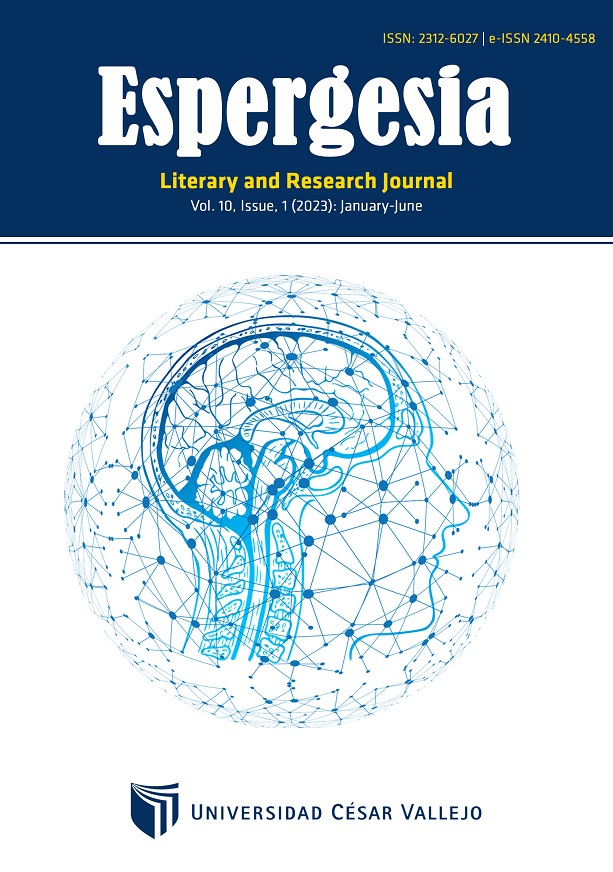Effects of the ‘Special Period’ on Cuban Cinema in the 1990s
DOI:
https://doi.org/10.18050/rev.espergesia.v10i1.2632Abstract
This study explored Cuban cinema of the 1990s, focusing on how films produced during the Special Period reflected the tensions and transformations within Cuban society. Cinema became a vehicle to address political, social, and cultural issues, utilizing cinematic narrative to offer a unique perspective on identity and everyday life during a period of profound change. The intended purpose was to comprehend how Cuban cinema of the 90s functioned as an artistic expression and a reflection on Cuban reality. Additionally, to elucidate how the films captured the duality between nostalgia for the past and a pessimistic perception of the present, while tackling subjects such as migration, the elderly, and human relationships in times of crisis. The conclusions reveal that Cuban cinema of the 90s challenged conventional expectations by addressing controversial themes and questioning political authority. Despite budgetary constraints, films like ‘Strawberry and Chocolate’ and ‘Guantanamera’ transcended national boundaries, resonating with global audiences and demonstrating cinema’s influence as an agent of social change. These films offered an authentic and nuanced look at Cuban reality, showcasing how adverse circumstances can inspire creativity and artistic expression while exploring and expressing the changing and challenging realities of the country.
Keywords: Cuban cinema; 1990s; Special Period; Cuban society; ICAIC.
References
Alonso Chiong, M., & Izquierdo Mirabal, J. (2006). ¿Herejía y látigo?... Relaciones entre la crítica y los filmes polémicos cubanos (1959-2005) [Trabajo de Diploma no publicado, Facultad de Comunicación, Universidad de La Habana]. http://cinelatinoamericano.org/biblioteca/fondo.aspx?cod=818
Arheim, R. (2008). El cine y la realidad. En Soberón Torchia, E. (Comp., 2008). 33 ensayos de cine. Escuela Internacional de Cine y TV, Colección Viramundo.
Arias Barreto, A., & Achang González, Z. (2007). Cuentos de hadas para retratar los sueños en las nubes. Del proceso de producción de documentales en la Televisión Serrana [Trabajo de Diploma no publicado, Universidad de La Habana.].
Basail Rodríguez, A., & Castañeda Seijas, M. Y. (2019). Fugas re-encantadas. Astucias cubanas de las identidades religiosas desde los noventa. Centro Regional de Formación-Consejo Latinoamericano de Ciencias Sociales (CLACSO).
Caballero, R., de Izcue, N., Getino, O., Cortés, M. L. (2014). Producción, Coproducción e Intercambio de Cine entre España, América Latina y el Caribe. Fundación del Nuevo Cine Latinoamericano. https://www.fundacioncarolina.es/wp-content/uploads/2014/07/Avance_Investigacion_5.pdf
Callegaro, A., Di Leo, A., & Mizrahi, E. (2017). Cine y cambio social: imágenes sociopolíticas de la Argentina 2002-2012. CLACSO / Universidad Nacional de La Matanza. https://www2.congreso.gob.pe/sicr/cendocbib/con5_uibd.nsf/EC8D1ED64006AE3A05258307006DD10E/$FILE/Cine_y_cambio_social.pdf
Castillo, L. (2007). El cine cubano a contraluz. Editorial Oriente
Del Río, J. (1995, 3 de diciembre). La penosa travesía de un sarcófago. Periódico Juventud Rebelde.
Díaz, M., & Del Río, J. (2010). Los cien caminos del cine cubano. Ediciones ICAIC.
Diez Castillo, D. (2013). Desde los sueños. Una experiencia audiovisual comunitaria y participativa. Ediciones La Memoria, Centro Cultural Pablo de la Torriente.
García Borrero, J. A. (2001). Guía crítica del cine cubano de ficción. Editorial Arte y Literatura.
Guevara, A. (1998). Revolución es lucidez. Ediciones ICAIC.
Gutiérrez Alea, T. (1968). Memorias del subdesarrollo: Notas de trabajo. Revista Cine cubano, 45, 45.
Hernández Morales, S. L. (2007). Cine cubano. El camino de las coproducciones [Tesis doctoral, Universidad de Santiago de Compostela]. Repositorio institucional: https://www.usc.gal/es/investigacion/grupos/cine/teses.jsp
Muíño, E. S. (2015). Opción Cero. Sostenibilidad y socialismo en la Cuba postsoviética: estudio de una transición sistémica ante al declive energético del siglo XXI [Tesis de Doctorado, Universidad Autónoma de Madrid]. Repositorio institucional: https://repositorio.uam.es/handle/10486/671458
Pérez Betancourt, R. (1995, 17 de noviembre). Guantanamera. Periódico Granma.
Pifferrer Quesada, K. (2012). Estudio sobre la relación entre los cambios socioeconómicos y las vías de financiación en la producción cinematográfica cubana de los años ´90 [Tesis de Maestría no publicada, Universidad de Holguín].
Rodríguez Calderín, J. (2007). La otredad en el largometraje y mediometraje de ficción producido por el ICAIC en la década de los noventa [Tesis de Maestría, Instituto Superior de Arte, Filial Camagüey].
Santovenia, R. (2006). Diccionario de cine. Términos artísticos y técnicos. Editorial Arte y Literatura.
Tornés Bernal, M. (2018). Visión de la tercera edad en el cine cubano (1959-2015) [Tesis de Maestría no publicada, Universidad de Holguín].
Valdivia, L. (2010). Las llamadas coproducciones en nuestro cine, en Pérez Padrón, A. (Comp.). Huellas olvidadas del cine cubano. Editorial Oriente, Colección Diálogos.
Downloads
Published
How to Cite
Issue
Section
License
Copyright (c) 2023 Maricarmen Tornés Bernal, Yoiner Díaz Rodríguez, Carlos Alberto Pupo Osorio, Leodanis Torres Barrero

This work is licensed under a Creative Commons Attribution 4.0 International License.







